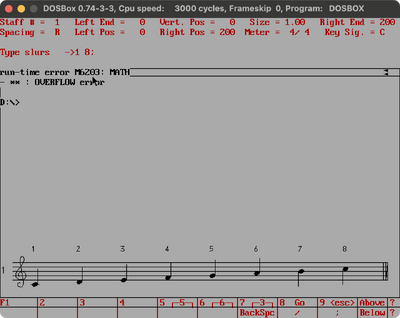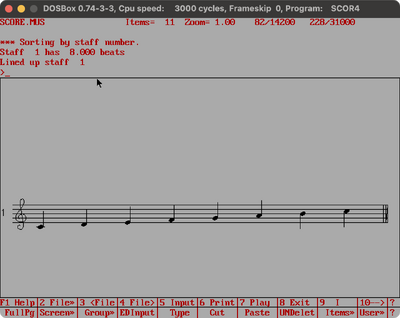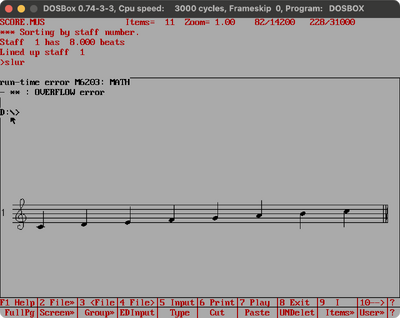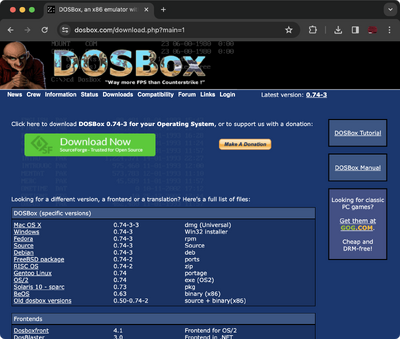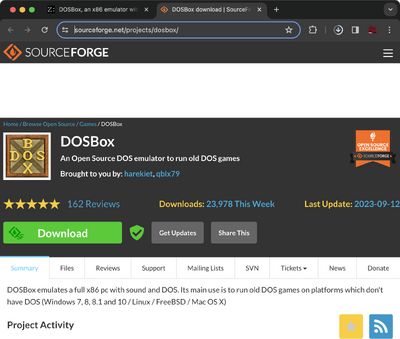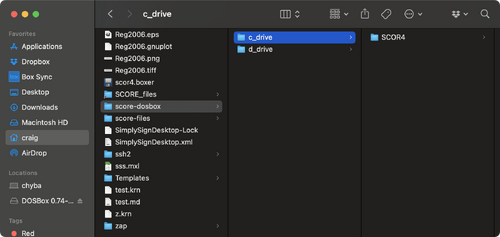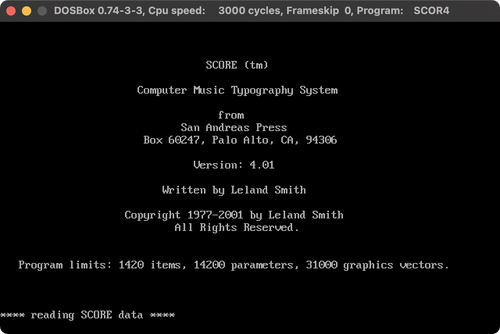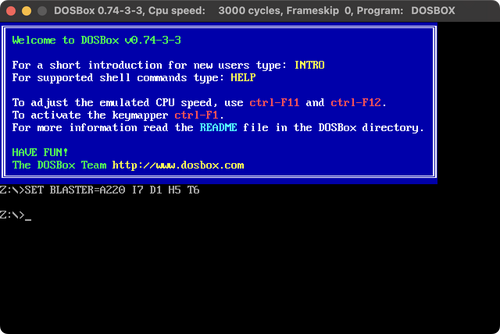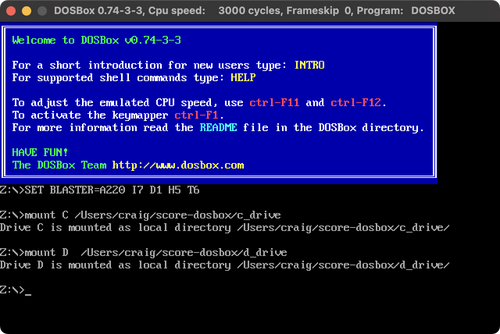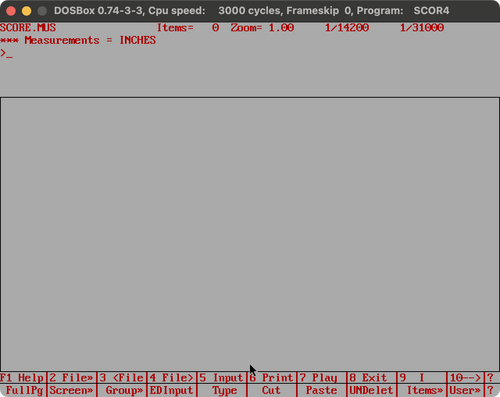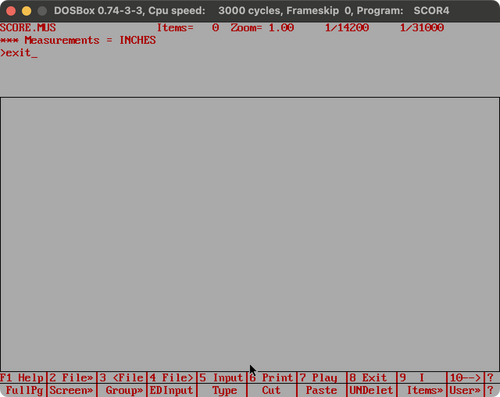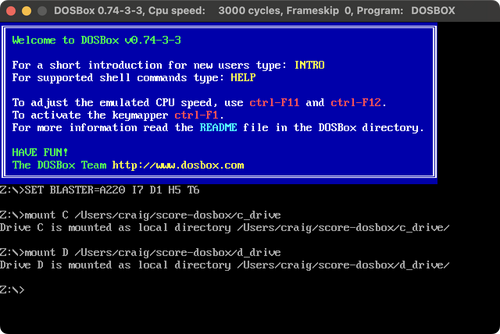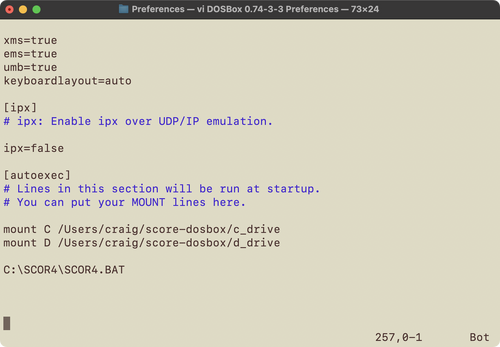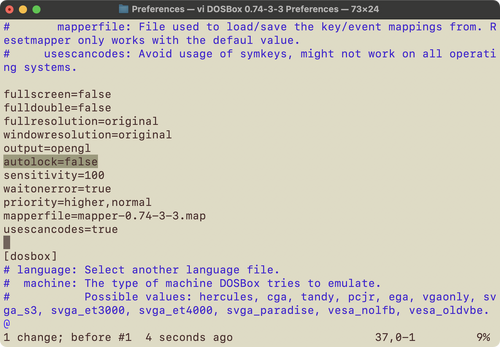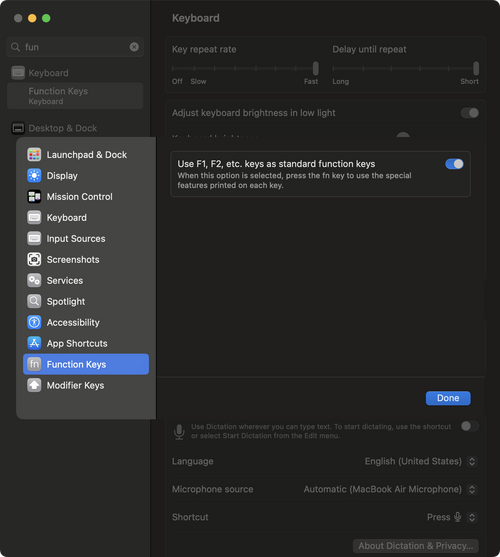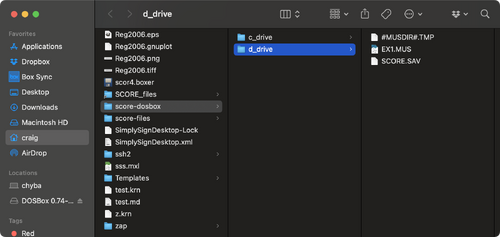Difference between revisions of "Using SCORE in DosBox"
| Line 10: | Line 10: | ||
[[File:dosbox-crash.png|400px|thumb|center|DosBox crash after adding a slur input mode.]] | [[File:dosbox-crash.png|400px|thumb|center|DosBox crash after adding a slur input mode.]] | ||
| − | The last line of input for the slurs was a single slur from the first note to the laste ("1 8;") | + | The last line of input for the slurs was a single slur from the first note to the laste ("1 8;"). Here is the input for the test: |
| + | |||
| + | tr/c4/pd/e/f/g/a/b/c/mh; | ||
| + | qx8; | ||
| + | ; | ||
| + | ; | ||
| + | 1 8; | ||
If there are no slurs added in input mode, then there is no crash: | If there are no slurs added in input mode, then there is no crash: | ||
Latest revision as of 02:43, 14 February 2024
Contents
Windows installation
Installation should be nearly identical to installing in MacOS, so tell me if there are any significant differences.
MacOS installation
There seems to be a bug in the emulator related to showing slurs at the end of data entry:
The last line of input for the slurs was a single slur from the first note to the laste ("1 8;"). Here is the input for the test:
tr/c4/pd/e/f/g/a/b/c/mh; qx8; ; ; 1 8;
If there are no slurs added in input mode, then there is no crash:
Here are the input stages used:
tr/c4/pd/e/f/g/a/b/c/mh; qx8; ; ; ;
So using SCORE with DosBox should not be used unless you don't want to add slurs. Trying to add the slur later in the main editor also causes a crash:
Download and install DosBox
- Install DosBox for Mac OS X version 0.74-3-3 dmg (Universal) from the download page of DosBox: [1]
- The Mac OS X link takes you to sorceforge [2] to download the application:
- Open the downloaded dmg file:
- The following files will be displayed. Copy the DOSBox.app program to "/Applications" or "~/Applications".
Download SCORE file
- Unzip the SCORE zip file and store where you want it to be stored. It should be able to go anywhere such as in your home directory, the Desktop, or a class-related folder. I would avoid having the full path contain any spaces, which could potentially cause problems. I place it at "/Users/craig/score-dosbox". (i.e., in the home directory).
- Run score by typing without quotes: "c:\scor4\scor4.bat". You should then see the SCORE splash page:
Run DosBox
- Note that there may be access permissons required the first time DosBox is run (so accept any security permission requests).
- Open the DosBox app (double click on "/Applications/DOSBox.app" or put in your Dock). You should see this view after a brief splash page:
- Make note of where you installed the score-dosbox directory/folder. There are two directories that need to be connected to DosBox as the C: and D: drives. For me the C: drive is /Users/craig/score-dosbox/c_drive, and the D: drive is /Users/craig/score-dosbox/d_drive.
- You need to type these two commands in DosBox:
mount C /Users/craig/score-dosbox/c_drive
and
mount D /Users/craig/score-dosbox/d_drive
- Now you can start score with the command:
c:\scor4\scor4.bat
and you should see the SCORE splash page:
Press the space bar (or any key) to skip the splash page faster.
- You will end up in the SCORE editor after the splash page is closed:
- You can type "exit" (then the return key) to close score and go back to the initial DosBox window:
Preference file
- You can automatically mount the C: and D: drives by adding these lines at the bottom of "/Users/craig/Library/Preferences/DOSBox 0.74-3-3 Preferences":
mount C /Users/craig/score-dosbox/c_drive mount D /Users/craig/score-dosbox/d_drive
(This should be in the "[autoexec]" options region.). After adding this, the mounting commands will be done automatically when opening DosBox:
- You can also add the command "C:\SCOR4\SCOR4.BAT" to the preference file after the mount commands to automatically start SCORE when DosBox is opened:
- Note that you must use back-slashes (\) and not forward slashes (/) for the command to start SCORE.
Tips
Mouse capture disabling
- To prevent DosBox from capturing the mouse, add this option to the Preference file:
autolock=false
within the "[sdl]" region of the preferences file:
Then you do not need to use control-F10 to release the mouse for DosBox.
Full screen view
- In order to get full screen mode by pressing option-return (and pressing again to go back to smaller window), I had to add this settings in the "[sdl]" region of the preference file:
fullresolution=1920x1080
The MacOS full resolution is probably too large, and otherwise DosBox will quite if I try to go to full screen.
Keyboard notes
See: https://www.dosbox.com/wiki/Special_Keys
- option-m toggles display of the menu at the bottom of the screen in the SCORE editor.
- option-i will show the arrow key increment for parameter editing
- Most keyboard shortcuts do not seem to work in MacOS.
- To use function keys in MacOS. press and hold the Fn key (bottom right of keyboard). The function keys can be switched to default meanings so that you do not need to type the Fn key, by going to the System Settings in the apple menu and searching for "function", Here is the window for setting function keys in MacOS, where the option to use function keys as function keys:
Continue
- Go to SCORE user input to start entering the first SCORE exercises.
- Also refer to the SCORE survival guide for step-by-step instructions on how to enter the exercises.
- When you save files, they will be placed in the /Users/craig/scores-dosbox/d_drive directory (at least for me). You can view the files in the Finder at the same location:
The files "#MUSDIR#.TMP" and "SCORE.SAV" are temporary files that SCORE uses. The file "EX1.MUS" is a binary file that stores the music notation prepared in SCORE.
- You can create readable ASCII versions of MUS files in SCORE by using the PMX command. Also you can use a command-line tool to convert binary MUS files into ASCII PMX (parameter maxtrix files), both show the internal format of the musical data which contain rows of numbers, each row representing a particular musical object on the page.
